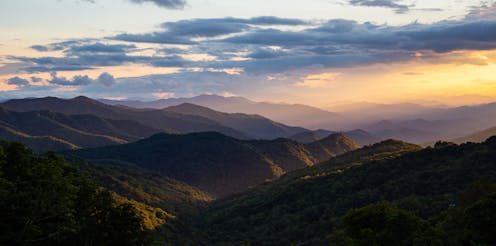National parks teach students about environmental issues in this course
- Written by Seth T. Kannarr, PhD Student in Geography, University of Tennessee

Why is this course relevant now?
Visitation numbers at national parks continue to rise each year[6]. Most of my students have been to at least one or two national parks and are exposed to their increasing presence on social media[7].
If this course was just titled Environmental Issues, I do not believe it would have the same kind of draw it has now. Typically, the course fills to capacity early on every semester.
Using the parks as teaching tools not only keeps students engaged and entertained in the class but also gives them real-life lessons about environmental issues. They get front-row seats in learning about how landscapes change and the physical factors that affect them, like climate, topography and vegetation.
What’s a critical lesson from the course?
I tell my students up front and repeatedly that the world is not black and white. Environmental issues are complex and difficult to solve.
For example, the bald eagle population in the U.S. fell drastically after World War II, and eventually they were declared endangered[8]. This was a result of being poisoned by the insecticide DDT.
Upon quick reflection, it seems that banning DDT[9] in the U.S. in 1972 was the obvious solution to save the bald eagle. Since then, there have also been international efforts to ban DDT[10] across the world for environmental reasons. But this leaves out the context that DDT kills mosquitoes, which spread the deadly disease malaria. In other parts of the world, DDT had saved an estimated 500 million lives[11] from malaria by the 1970s.
This example shows the nuance that’s required when thinking about environmental issues and solutions. Sometimes there is not an obvious right answer, and students visibly struggle to address ethical questions like these.
What materials does the course feature?
I do not use a central textbook or provide specific assigned readings. Instead, students participate in group activities, enjoy illustrated lecture slideshows and YouTube videos and work with online resources.
One assignment has students use Google Earth to create a guided tour of a national park of their choice. They play the role of a park ranger through their written descriptions of tour stops. Students enjoy getting to choose which national park they would like to explore and highlight for visitors.
What will the course prepare students to do?
Upon completing the course, I want students to become critical visitors of national parks and protected areas. I want them to be aware of the role they play in what happens in those spaces and of the complexities of the issues there. Examples could include the continual overcrowding[12] of national parks, the removal of Indigenous peoples[13] from these lands or the history of Black discrimination in our parks[14].
Whether grappling with strictly environmental issues or the larger political and social struggles related to the national parks, I want students to open their minds to new perspectives. In a way, this course is an intervention for students to understand that they can make a difference and help shape an ever-changing world.
References
- ^ Uncommon Courses (theconversation.com)
- ^ Great Smoky Mountains National Park (www.nps.gov)
- ^ Sequoia National Park (www.nps.gov)
- ^ maintain the ecosystem (www.nps.gov)
- ^ Look Rock Tower (www.pigeonforge.com)
- ^ continue to rise each year (www.nps.gov)
- ^ increasing presence on social media (doi.org)
- ^ declared endangered (www.fws.gov)
- ^ banning DDT (www.epa.gov)
- ^ international efforts to ban DDT (www.epa.gov)
- ^ estimated 500 million lives (www.jstor.org)
- ^ continual overcrowding (theconversation.com)
- ^ removal of Indigenous peoples (theconversation.com)
- ^ history of Black discrimination in our parks (theconversation.com)
Authors: Seth T. Kannarr, PhD Student in Geography, University of Tennessee

